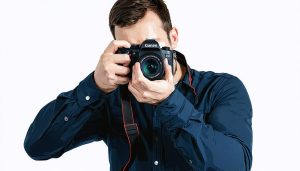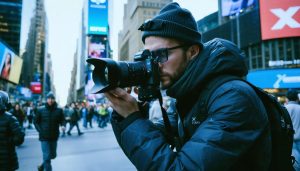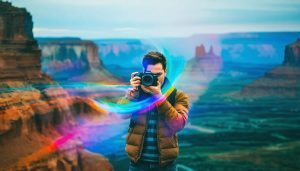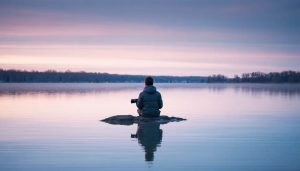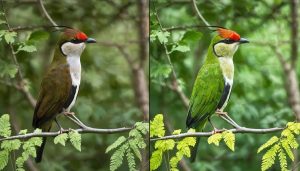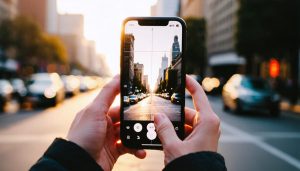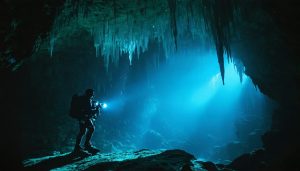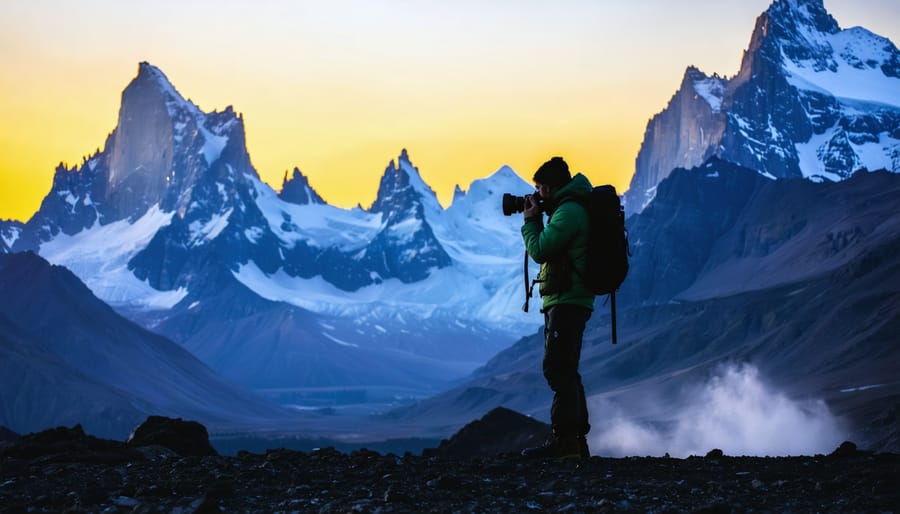
Venture deep into uncharted territories with your camera, where every frame tells a story of discovery and wonder. Exploration photography merges the raw thrill of adventure with the technical precision of visual storytelling, capturing moments that most people will never witness firsthand. Whether scaling ice-capped peaks or documenting remote indigenous communities, this demanding craft requires not just photographic expertise, but also the resilience of an explorer and the instincts of a storyteller.
From the harsh extremes of desert landscapes to the humid depths of rainforest canopies, exploration photographers must master both their equipment and environment simultaneously. Success demands more than just technical proficiency—it requires careful preparation, physical endurance, and the ability to anticipate fleeting moments in challenging conditions. Each image becomes a delicate balance between artistic vision and real-world constraints, where photographers must work with unpredictable weather, difficult terrain, and often just seconds to capture decisive moments.
In this comprehensive guide, we’ll delve into the essential techniques, gear considerations, and creative approaches that define successful exploration photography. Whether you’re documenting scientific expeditions, cultural encounters, or pristine wilderness, you’ll discover how to create compelling visual narratives while maintaining the highest technical standards in even the most challenging situations.
Essential Gear for the Adventurous Photographer
Weather-Resistant Camera Systems
When venturing into challenging environments, your camera gear needs to be as resilient as your adventurous spirit. Weather-sealed cameras and lenses form the backbone of exploration photography, offering protection against dust, moisture, and extreme temperatures. Professional-grade bodies like the Nikon D850 and Sony A7R IV feature robust weather sealing around all buttons, dials, and compartments.
Beyond built-in weather resistance, consider additional protection layers. Quality rain covers provide excellent defense against unexpected downpours, while silica gel packets in your camera bag help combat humidity. For arctic or desert conditions, insulated camera covers protect your gear from temperature extremes that can affect battery life and sensor performance.
Remember that weather resistance isn’t waterproofing. While most professional cameras can handle light rain, they’re not designed for submersion. When shooting in harsh conditions, pay special attention to lens changes – the sensor is most vulnerable during this process. A clean microfiber cloth should always be within reach to quickly dry off any moisture.
For ultimate protection in extreme environments, underwater housings or dedicated all-weather cameras might be worth the investment, especially if your explorations frequently take you into challenging weather conditions.
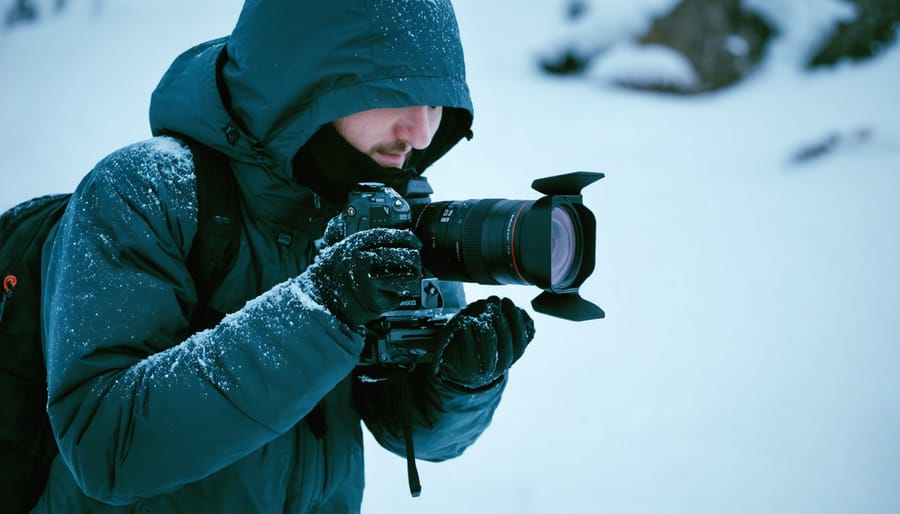
Versatile Lens Selection
When venturing into the world of exploration photography, your lens selection can make or break your shots. A versatile kit typically starts with a reliable 24-70mm zoom lens, perfect for capturing both sweeping landscapes and environmental portraits. This workhorse lens offers excellent flexibility without compromising image quality.
For more dramatic landscapes and architectural shots, consider carrying a wide-angle lens in the 16-35mm range. These lenses excel at emphasizing foreground elements while maintaining an expansive field of view, ideal for capturing towering mountains or narrow canyon walls.
Don’t overlook the value of a quality telephoto lens, particularly a 70-200mm. This focal range proves invaluable for wildlife encounters and compressing distant landscape elements. For expeditions where weight is crucial, a lightweight 70-300mm can serve as a practical alternative.
Macro capabilities shouldn’t be forgotten – whether through a dedicated macro lens or extension tubes, the ability to capture intricate details of flora, textures, and small artifacts can add fascinating layers to your exploration narrative. Remember, the best lens combination depends on your specific adventure goals and weight constraints. Explore a range of top Sony lenses to complement your photography needs.
Support and Protection Equipment
When venturing into challenging environments, reliable support and protection equipment becomes your gear’s best friend. A sturdy, lightweight carbon fiber tripod is essential for sharp images in low light and for capturing long exposures of waterfalls or starlit landscapes. Consider models with removable leg sections that convert into a monopod for added versatility.
Weather-sealed camera bags designed specifically for outdoor use protect your equipment while providing quick access to gear. Look for bags with reinforced water-resistant materials, multiple access points, and adequate padding. Many photographers opt for modular systems that can be customized based on the expedition’s needs.
Don’t overlook essential protective accessories like lens filters, rain covers, and silica gel packets. UV filters shield your lenses from scratches and debris, while polarizing filters enhance colors and reduce glare. A well-thought-out protection system means you can focus on creating images rather than worrying about your equipment’s safety.
Planning Your Photographic Expedition
Location Research and Scouting
Successful exploration photography begins long before you press the shutter button. The key to capturing compelling images lies in thorough location research and careful scouting. Start by utilizing online resources like Google Earth, hiking websites, and photography forums to get a bird’s-eye view of potential shooting locations and gather insights from other photographers.
Weather apps and sun-tracking tools are invaluable for planning optimal shooting times. Apps like PhotoPills or The Photographer’s Ephemeris help you predict golden hour, blue hour, and the position of celestial bodies, ensuring you’re in the right place at the right time for dramatic lighting conditions.
When possible, visit your location at least once before your actual shoot. Take note of unique features, potential hazards, and composition possibilities. Consider visiting during different times of day to understand how light interacts with the landscape. Look for natural leading lines, interesting foreground elements, and distinctive viewpoints that could create compelling photographs.
During scouting trips, mark GPS coordinates of promising spots and take reference photos with your smartphone. Make notes about access points, parking options, and terrain difficulties. Research local regulations, permits required, and seasonal restrictions that might affect your shoot.
Don’t forget to consider practical aspects like cell phone coverage, nearest facilities, and emergency access points. Being well-prepared not only ensures better images but also contributes to a safer and more enjoyable photography experience.
Timing and Light Conditions
Light is the essence of photography, and in exploration photography, understanding natural light can make the difference between a good shot and a spectacular one. The golden hours – just after sunrise and before sunset – offer warm, directional light that adds depth and drama to landscapes and subjects. These optimal shooting times provide soft, flattering light that minimizes harsh shadows and creates a magical atmosphere in your images.
During midday, when the sun is at its highest, you’ll face challenging lighting conditions with strong contrast and deep shadows. Combat this by seeking out shade, using diffusers, or focusing on detail shots and close-ups. Overcast days can be perfect for photographing in forests or capturing subtle textures, as the clouds act as a natural softbox.
Blue hour, occurring just before sunrise and after sunset, offers ethereal blue tones that work beautifully for cityscapes and architectural elements during urban exploration. For night photography, plan around moon phases – a full moon can illuminate landscapes naturally, while new moons are ideal for astrophotography and star trails.
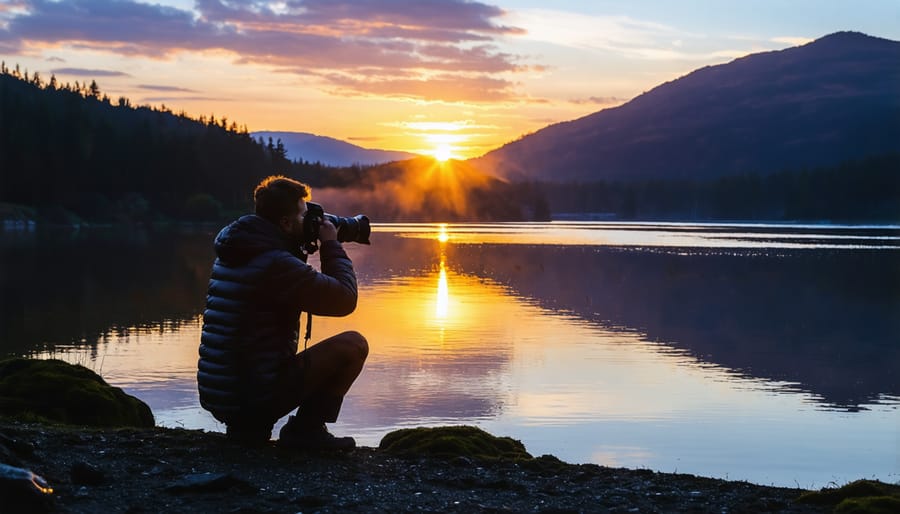
Safety and Accessibility Considerations
Safety should always be your top priority when pursuing exploration photography. Never compromise your well-being for a shot, no matter how compelling it might be. Always research your location thoroughly beforehand, checking weather conditions, terrain challenges, and potential hazards.
When photographing in remote areas, travel with a companion whenever possible and always share your intended route and expected return time with someone reliable. Carry essential safety gear including a first aid kit, emergency shelter, extra batteries, and a reliable communication device. In areas without cell service, consider bringing a satellite phone or GPS emergency beacon.
Be mindful of local regulations and obtain necessary permits before accessing restricted areas. Respect private property boundaries and protected natural spaces. When photographing in culturally sensitive locations, research and follow appropriate protocols and customs.
Pack appropriate clothing and gear for changing weather conditions, and bring enough water and food. Consider the weight of your camera equipment when planning longer hikes, and use a comfortable, well-balanced camera bag to prevent strain injuries. Remember that challenging lighting conditions often occur during dawn and dusk – times when wildlife is most active – so extra caution is needed during these periods.
Field Techniques for Stunning Results
Composition in Natural Environments
When composing shots in challenging locations, natural environments demand a unique approach to photography. The key is to work with, rather than against, the elements around you. Start by identifying natural leading lines, such as fallen trees, river paths, or mountain ridges, to guide viewers through your frame.
Consider the golden hours – just after sunrise and before sunset – when natural light creates dramatic shadows and warm tones that can transform an ordinary landscape into something extraordinary. However, don’t shy away from challenging weather conditions; stormy skies and fog can add mood and mystery to your images.
Remember the rule of thirds, but be prepared to break it when nature presents a more compelling composition. Use natural frames like rock formations or tree branches to add depth and context to your shots. When photographing wildlife or flora, pay attention to the background and ensure it complements rather than distracts from your subject.
Movement in nature, such as flowing water or swaying grass, can be captured through various shutter speeds to create different effects. Try both fast speeds to freeze motion and slower speeds to create smooth, dreamy effects. Position yourself thoughtfully – sometimes getting low to the ground or finding an elevated vantage point can dramatically improve your composition.
Always respect the environment and maintain a safe distance from wildlife while shooting. The best compositions often come from patience and careful observation of your surroundings.
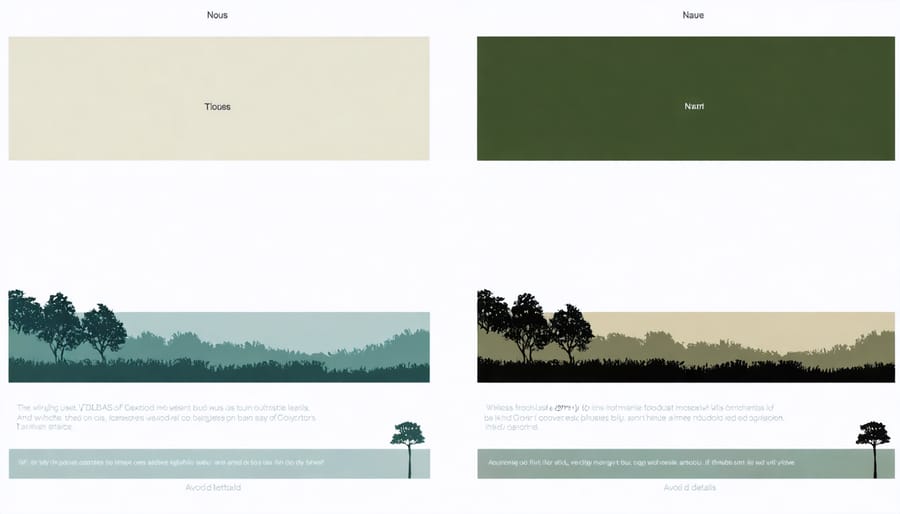
Working with Natural Light
Natural light is your most valuable ally in exploration photography, but it can also be your greatest challenge. The key to mastering natural light lies in understanding how it changes throughout the day and adapting your shooting techniques accordingly.
During golden hour – the period shortly after sunrise or before sunset – you’ll find warm, directional light that creates stunning shadows and highlights. Position your subjects to take advantage of this side-lighting, which adds depth and dimension to your images. In contrast, the harsh midday sun poses unique challenges. Combat this by seeking out open shade or creating your own using natural features like rock formations or dense foliage.
Overcast conditions offer their own opportunities. These diffused lighting situations are perfect for capturing the rich colors of landscapes and eliminating harsh shadows on subjects. When shooting in forests or canyons, look for light beams filtering through trees or narrow openings – these can create dramatic spotlighting effects that add mystery to your images.
Always carry a reflector in your pack; it’s lightweight and can help bounce light back onto shadowed areas of your subject. For challenging low-light situations, such as dawn expeditions or twilight adventures, consider shooting at wider apertures and higher ISOs, but be mindful of your camera’s noise limitations. Check out our guide on conquering low light shots for essential camera settings.
Remember that weather conditions can change rapidly during explorations, so stay flexible and be prepared to adjust your settings quickly to capture those fleeting moments when the light is perfect.
Capturing Scale and Perspective
Conveying scale and perspective in exploration photography can be challenging, especially when photographing vast landscapes or unusual environments. One effective technique is to include a human element or familiar object in your frame. A person standing near a towering cliff face or ancient ruins instantly gives viewers a reference point for size, making the scene’s grandeur more impactful.
Leading lines are another powerful tool for creating depth in your images. Natural pathways, rivers, or rock formations can guide the viewer’s eye through the frame and enhance the sense of distance. When photographing in caves or narrow canyons, position yourself to capture these natural lines as they converge in the distance.
Consider using different perspectives to emphasize scale. Getting low to the ground can make foreground elements appear larger and more dramatic, while shooting from an elevated position can reveal the expansive nature of a landscape. In tight spaces like slot canyons, try shooting straight up to showcase the towering walls and create a sense of confinement.
Layer your compositions with foreground, middle-ground, and background elements to add depth. This technique works particularly well in mountain landscapes, where you might include rocks or flowers in the foreground, a lake in the middle ground, and peaks in the background. During golden hour or blue hour, these layers become even more distinct as atmospheric conditions create natural depth through color and light variation.
Post-Processing for Impact
Raw Processing Essentials
Raw processing is the crucial first step in turning your expedition captures into compelling visual stories. Start by establishing a consistent photography workflow that begins with importing your RAW files and making essential adjustments.
Focus first on white balance correction, especially important when dealing with varying natural light conditions during explorations. The golden hours of sunrise and sunset often introduce color casts that need fine-tuning to match what you witnessed in the field.
Exposure adjustments come next – recover highlight details from bright skies and pull shadow details from darker areas. For landscape shots, carefully adjust the highlights slider to preserve cloud detail while maintaining a natural look. When processing images of local communities or wildlife, pay special attention to skin tones and natural coloring.
Lens corrections are particularly important for exploration photography, where wide-angle shots often suffer from distortion. Enable profile corrections to address vignetting and chromatic aberration, common issues when shooting in challenging environments.
Finally, apply subtle clarity and vibrance adjustments to enhance texture and color without making images look artificial. Remember, the goal is to maintain authenticity while bringing out the best in your captured moments. Keep your adjustments measured – you want viewers to feel the authenticity of your adventures, not question their reality.
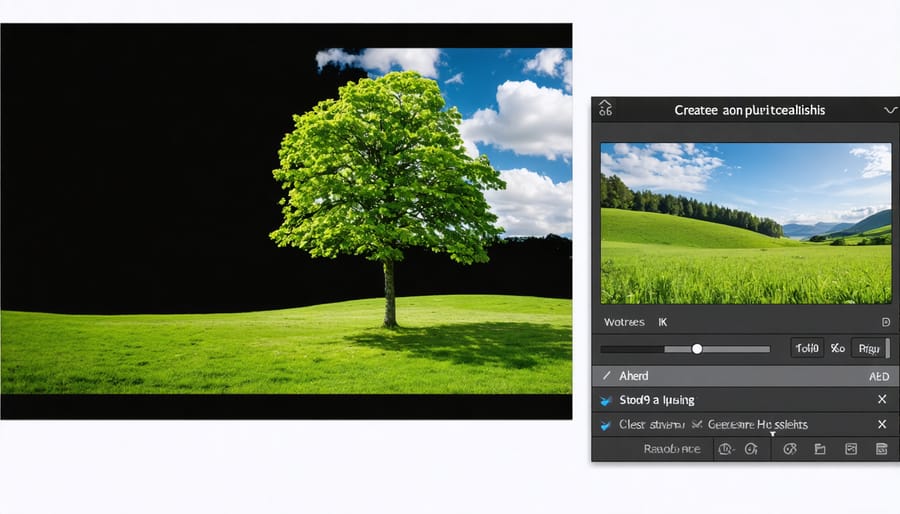
Advanced Editing Techniques
Post-processing plays a vital role in exploration photography, transforming raw captures into compelling visual stories. Start by mastering exposure blending techniques to handle the extreme lighting conditions often encountered in the field. This involves combining multiple exposures to retain both shadow and highlight details, particularly useful for sunrise shots or cave entrances where contrast can be challenging.
Color grading is another powerful tool in your arsenal. Develop a consistent style that reflects the mood of your adventures while remaining true to the scene. For instance, subtle warming of golden hour images can enhance the feeling of dawn exploration, while cooler tones might better convey the atmosphere of glacial landscapes.
Focus stacking has become increasingly important for exploration photographers, especially when capturing intricate details in challenging environments. This technique allows you to maintain sharpness from foreground elements to distant backgrounds, crucial for documenting archaeological sites or capturing expansive cave systems.
Consider creating panoramic compositions by stitching multiple images together, particularly useful when working in tight spaces where you can’t physically back up enough to capture the entire scene. Remember to maintain a balance between creative enhancement and authenticity – your goal is to convey the true essence of the location while making it visually compelling.
Develop presets or adjustment recipes that work well with your typical shooting conditions, but always fine-tune each image individually to honor its unique characteristics and story.
Storytelling Through Your Images
Great photographs do more than just document a moment; they tell a story that captivates viewers and transports them to the heart of your adventure. To create compelling visual narratives, start by identifying the key elements that make your exploration unique – whether it’s the challenging terrain, local culture, or dramatic weather conditions.
Consider your image sequence carefully. Just like a written story, your photo series should have a clear beginning, middle, and end. Begin with scene-setting shots that establish the location and context. Follow with action shots that reveal the journey’s challenges and discoveries. End with powerful closing images that provide resolution or reflection.
Use varying perspectives to add depth to your narrative. Combine wide landscape shots showing the grand scale of your environment with intimate detail shots that reveal texture and character. Include human elements to create emotional connection – perhaps a climber’s weathered hands or a fellow explorer’s expression of wonder.
Pay attention to lighting and timing to enhance mood. Dawn and dusk often provide dramatic natural lighting that can elevate your storytelling. Weather conditions, too, can be powerful narrative elements – fog adding mystery, storm clouds creating drama, or sunshine highlighting victory moments.
Remember that strong visual narratives often leave room for interpretation. Don’t feel compelled to show everything; sometimes what you leave out can be as powerful as what you include. Let viewers fill in the gaps with their imagination, making them active participants in your exploration story.
Exploration photography represents a unique blend of adventure, artistry, and technical skill that can transform your travel experiences into lasting visual stories. Throughout this guide, we’ve covered essential aspects from choosing the right gear and mastering technical skills to understanding composition and storytelling through your lens. Remember that successful exploration photography isn’t just about capturing beautiful landscapes – it’s about conveying the emotion, atmosphere, and narrative of your journey.
Whether you’re planning an expedition to remote wilderness areas or exploring urban environments, the principles we’ve discussed will help you create compelling images that resonate with viewers. Start small by practicing in your local area, gradually building your skills and confidence before tackling more challenging environments. Experiment with different techniques, lighting conditions, and perspectives to develop your unique style.
Don’t let perfectionism hold you back – some of the most memorable images come from spontaneous moments and unexpected situations. Pack your camera, step outside your comfort zone, and begin documenting your adventures. The world of exploration photography awaits, offering endless opportunities to grow as both a photographer and storyteller.

